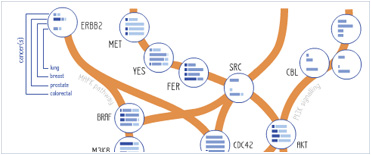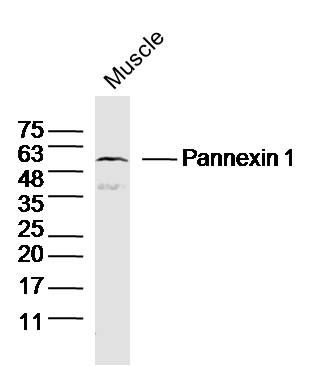Pannexin 1 Polyclonal Antibody
Purified Rabbit Polyclonal Antibody (Pab)
- SPECIFICATION
- CITATIONS
- PROTOCOLS
- BACKGROUND

Application
| WB, IHC-P, IHC-F, IF, ICC, E |
|---|---|
| Primary Accession | Q96RD7 |
| Reactivity | Rat, Bovine |
| Host | Rabbit |
| Clonality | Polyclonal |
| Calculated MW | 48 KDa |
| Physical State | Liquid |
| Immunogen | KLH conjugated synthetic peptide derived from human Pannexin 1 |
| Epitope Specificity | 61-106/426 |
| Isotype | IgG |
| Purity | affinity purified by Protein A |
| Buffer | 0.01M TBS (pH7.4) with 1% BSA, 0.02% Proclin300 and 50% Glycerol. |
| SUBCELLULAR LOCATION | Cell membrane. Cell junction > gap junction. Endoplasmic reticulum membrane. |
| SIMILARITY | Belongs to the pannexin family. |
| SUBUNIT | Homohexamer. Forms homomeric or PANX1/PANX2-heteromeric intercellular channels on coexpression in paired Xenopus oocytes (By similarity). |
| Important Note | This product as supplied is intended for research use only, not for use in human, therapeutic or diagnostic applications. |
| Background Descriptions | The protein encoded by this gene belongs to the innexin family. Innexin family members are the structural components of gap junctions. This protein and pannexin 2 are abundantly expressed in central nerve system (CNS) and are coexpressed in various neuronal populations. Studies in Xenopus oocytes suggest that this protein alone and in combination with pannexin 2 may form cell type-specific gap junctions with distinct properties. [provided by RefSeq, Jul 2008] |
| Gene ID | 24145 |
|---|---|
| Other Names | Pannexin-1, PANX1 (HGNC:8599), MRS1 |
| Dilution | WB=1:500-2000,IHC-P=1:100-500,IHC-F=1:100-500,ICC=1:100-500,IF=1:100-500,ELISA=1:5000-10000 |
| Format | 0.01M TBS(pH7.4), 0.09% (W/V) sodium azide and 50% Glyce |
| Storage | Store at -20 ℃ for one year. Avoid repeated freeze/thaw cycles. When reconstituted in sterile pH 7.4 0.01M PBS or diluent of antibody the antibody is stable for at least two weeks at 2-4 ℃. |
| Name | PANX1 (HGNC:8599) |
|---|---|
| Function | Ion channel involved in a variety of physiological functions such as blood pressure regulation, apoptotic cell clearance and oogenesis (PubMed:15304325, PubMed:16908669, PubMed:20829356, PubMed:20944749, PubMed:30918116). Forms anion-selective channels with relatively low conductance and an order of permeabilities: nitrate>iodide>chlroride>>aspartate=glutamate=gluconate (By similarity). Can release ATP upon activation through phosphorylation or cleavage at C-terminus (PubMed:32238926). May play a role as a Ca(2+)- leak channel to regulate ER Ca(2+) homeostasis (PubMed:16908669). |
| Cellular Location | Cell membrane; Multi-pass membrane protein {ECO:0000255|PROSITE-ProRule:PRU00351}. Endoplasmic reticulum membrane; Multi-pass membrane protein {ECO:0000255|PROSITE-ProRule:PRU00351} |
| Tissue Location | Widely expressed (PubMed:30918116). Highest expression is observed in oocytes and brain (PubMed:30918116). Detected at very low levels in sperm cells (PubMed:30918116) |

Thousands of laboratories across the world have published research that depended on the performance of antibodies from Abcepta to advance their research. Check out links to articles that cite our products in major peer-reviewed journals, organized by research category.
info@abcepta.com, and receive a free "I Love Antibodies" mug.
Provided below are standard protocols that you may find useful for product applications.
If you have used an Abcepta product and would like to share how it has performed, please click on the "Submit Review" button and provide the requested information. Our staff will examine and post your review and contact you if needed.
If you have any additional inquiries please email technical services at tech@abcepta.com.













 Foundational characteristics of cancer include proliferation, angiogenesis, migration, evasion of apoptosis, and cellular immortality. Find key markers for these cellular processes and antibodies to detect them.
Foundational characteristics of cancer include proliferation, angiogenesis, migration, evasion of apoptosis, and cellular immortality. Find key markers for these cellular processes and antibodies to detect them. The SUMOplot™ Analysis Program predicts and scores sumoylation sites in your protein. SUMOylation is a post-translational modification involved in various cellular processes, such as nuclear-cytosolic transport, transcriptional regulation, apoptosis, protein stability, response to stress, and progression through the cell cycle.
The SUMOplot™ Analysis Program predicts and scores sumoylation sites in your protein. SUMOylation is a post-translational modification involved in various cellular processes, such as nuclear-cytosolic transport, transcriptional regulation, apoptosis, protein stability, response to stress, and progression through the cell cycle. The Autophagy Receptor Motif Plotter predicts and scores autophagy receptor binding sites in your protein. Identifying proteins connected to this pathway is critical to understanding the role of autophagy in physiological as well as pathological processes such as development, differentiation, neurodegenerative diseases, stress, infection, and cancer.
The Autophagy Receptor Motif Plotter predicts and scores autophagy receptor binding sites in your protein. Identifying proteins connected to this pathway is critical to understanding the role of autophagy in physiological as well as pathological processes such as development, differentiation, neurodegenerative diseases, stress, infection, and cancer.


